Accommodating Refugees: Sustainability Issues in Australia
VerifiedAdded on 2020/03/16
|9
|2630
|50
Essay
AI Summary
This essay explores the sustainability issues associated with accommodating and ensuring the well-being of refugee populations in Australia, analyzing the challenges from environmental, social, and economic perspectives. Environmentally, the essay highlights overpopulation, environmental degradation, deforestation, and pollution resulting from increased refugee populations. Socially, it addresses issues such as the denial of social rights, lack of clean water, and competition for resources, potentially leading to social tensions and psychological stress. Economically, the essay discusses the increased demand for resources, inflation, and potential economic crises. The essay also proposes solutions such as controlling refugee numbers, promoting environmental conservation, fostering social integration through language and cultural programs, prioritizing high-risk refugees, and promoting the use of renewable energy sources to achieve long-term sustainability.
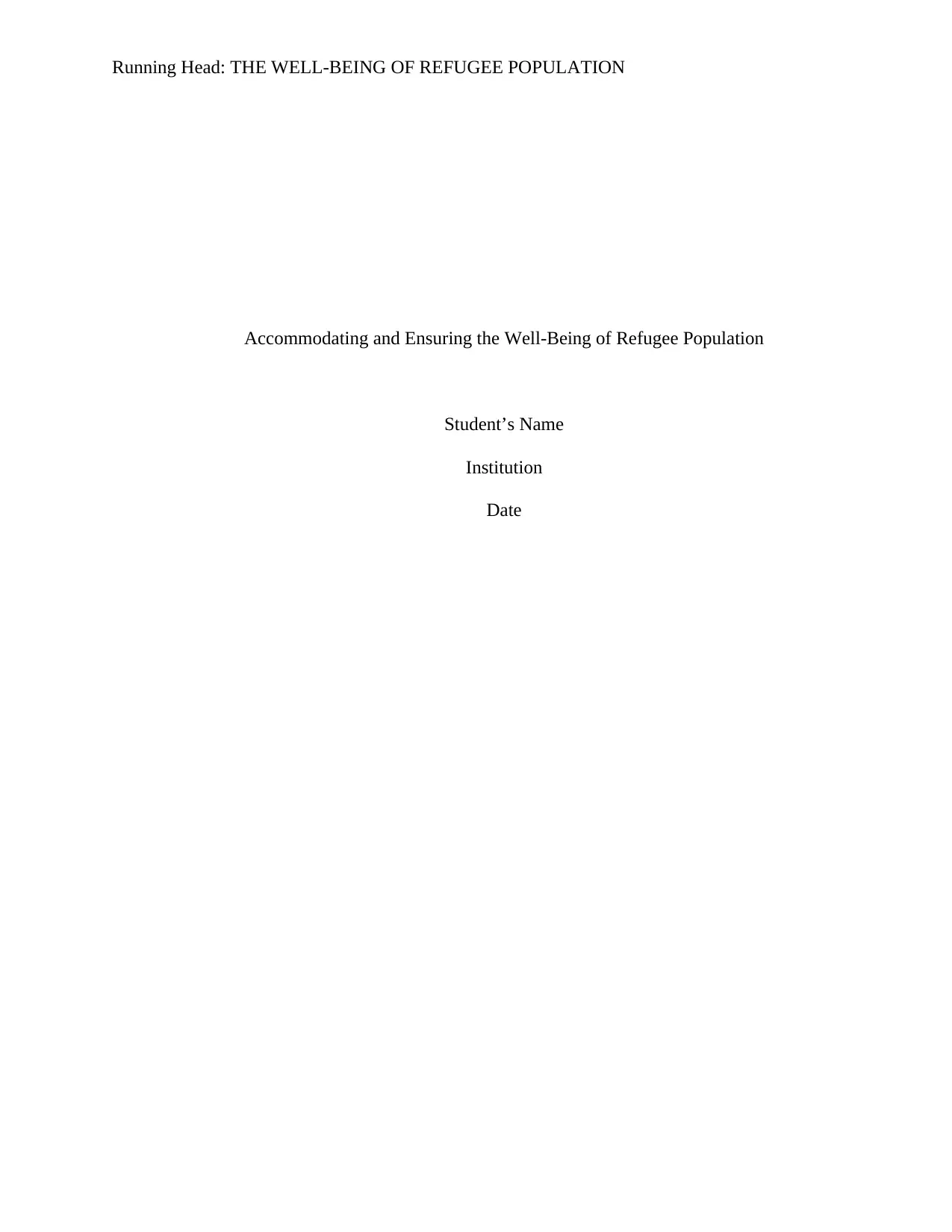
Running Head: THE WELL-BEING OF REFUGEE POPULATION
Accommodating and Ensuring the Well-Being of Refugee Population
Student’s Name
Institution
Date
Accommodating and Ensuring the Well-Being of Refugee Population
Student’s Name
Institution
Date
Paraphrase This Document
Need a fresh take? Get an instant paraphrase of this document with our AI Paraphraser
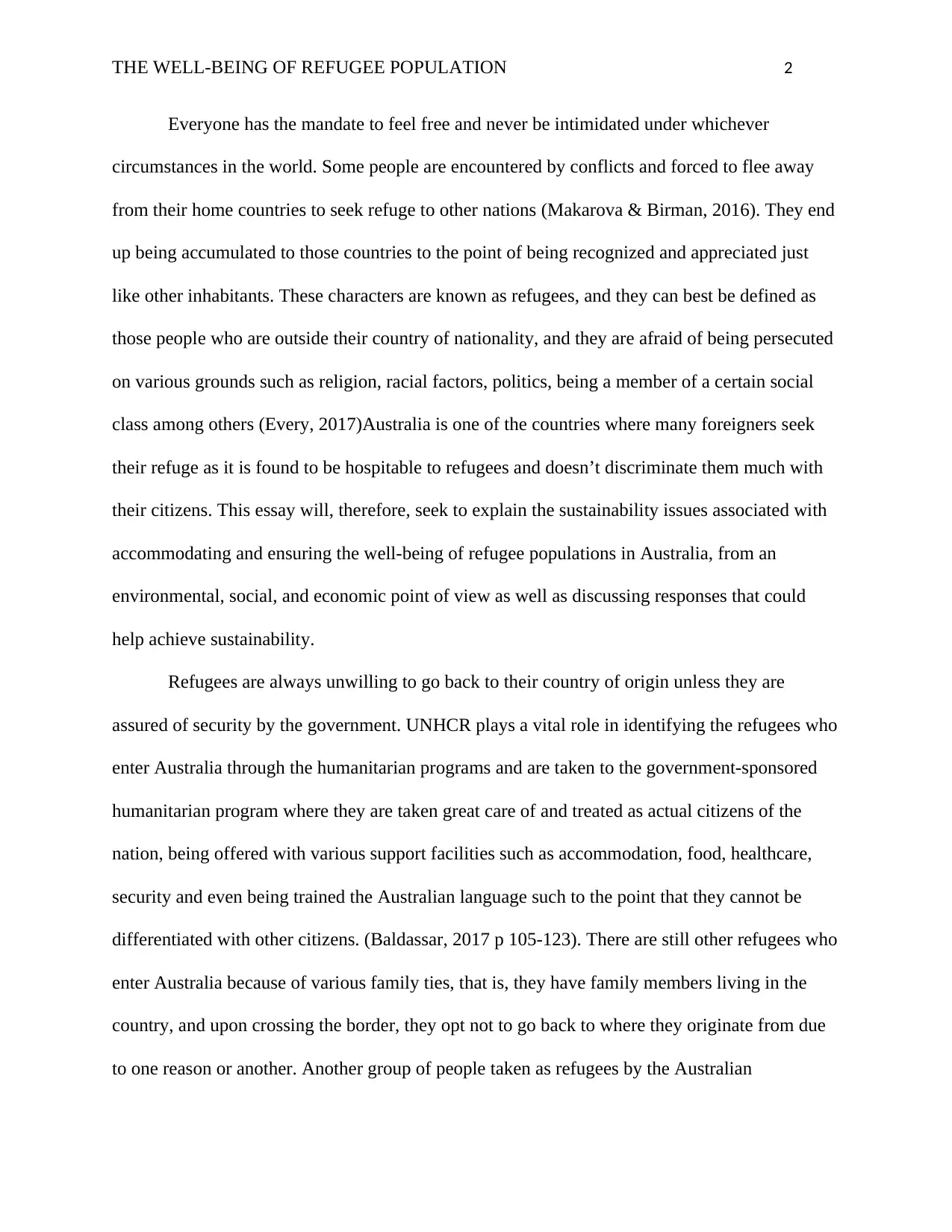
THE WELL-BEING OF REFUGEE POPULATION 2
Everyone has the mandate to feel free and never be intimidated under whichever
circumstances in the world. Some people are encountered by conflicts and forced to flee away
from their home countries to seek refuge to other nations (Makarova & Birman, 2016). They end
up being accumulated to those countries to the point of being recognized and appreciated just
like other inhabitants. These characters are known as refugees, and they can best be defined as
those people who are outside their country of nationality, and they are afraid of being persecuted
on various grounds such as religion, racial factors, politics, being a member of a certain social
class among others (Every, 2017)Australia is one of the countries where many foreigners seek
their refuge as it is found to be hospitable to refugees and doesn’t discriminate them much with
their citizens. This essay will, therefore, seek to explain the sustainability issues associated with
accommodating and ensuring the well-being of refugee populations in Australia, from an
environmental, social, and economic point of view as well as discussing responses that could
help achieve sustainability.
Refugees are always unwilling to go back to their country of origin unless they are
assured of security by the government. UNHCR plays a vital role in identifying the refugees who
enter Australia through the humanitarian programs and are taken to the government-sponsored
humanitarian program where they are taken great care of and treated as actual citizens of the
nation, being offered with various support facilities such as accommodation, food, healthcare,
security and even being trained the Australian language such to the point that they cannot be
differentiated with other citizens. (Baldassar, 2017 p 105-123). There are still other refugees who
enter Australia because of various family ties, that is, they have family members living in the
country, and upon crossing the border, they opt not to go back to where they originate from due
to one reason or another. Another group of people taken as refugees by the Australian
Everyone has the mandate to feel free and never be intimidated under whichever
circumstances in the world. Some people are encountered by conflicts and forced to flee away
from their home countries to seek refuge to other nations (Makarova & Birman, 2016). They end
up being accumulated to those countries to the point of being recognized and appreciated just
like other inhabitants. These characters are known as refugees, and they can best be defined as
those people who are outside their country of nationality, and they are afraid of being persecuted
on various grounds such as religion, racial factors, politics, being a member of a certain social
class among others (Every, 2017)Australia is one of the countries where many foreigners seek
their refuge as it is found to be hospitable to refugees and doesn’t discriminate them much with
their citizens. This essay will, therefore, seek to explain the sustainability issues associated with
accommodating and ensuring the well-being of refugee populations in Australia, from an
environmental, social, and economic point of view as well as discussing responses that could
help achieve sustainability.
Refugees are always unwilling to go back to their country of origin unless they are
assured of security by the government. UNHCR plays a vital role in identifying the refugees who
enter Australia through the humanitarian programs and are taken to the government-sponsored
humanitarian program where they are taken great care of and treated as actual citizens of the
nation, being offered with various support facilities such as accommodation, food, healthcare,
security and even being trained the Australian language such to the point that they cannot be
differentiated with other citizens. (Baldassar, 2017 p 105-123). There are still other refugees who
enter Australia because of various family ties, that is, they have family members living in the
country, and upon crossing the border, they opt not to go back to where they originate from due
to one reason or another. Another group of people taken as refugees by the Australian
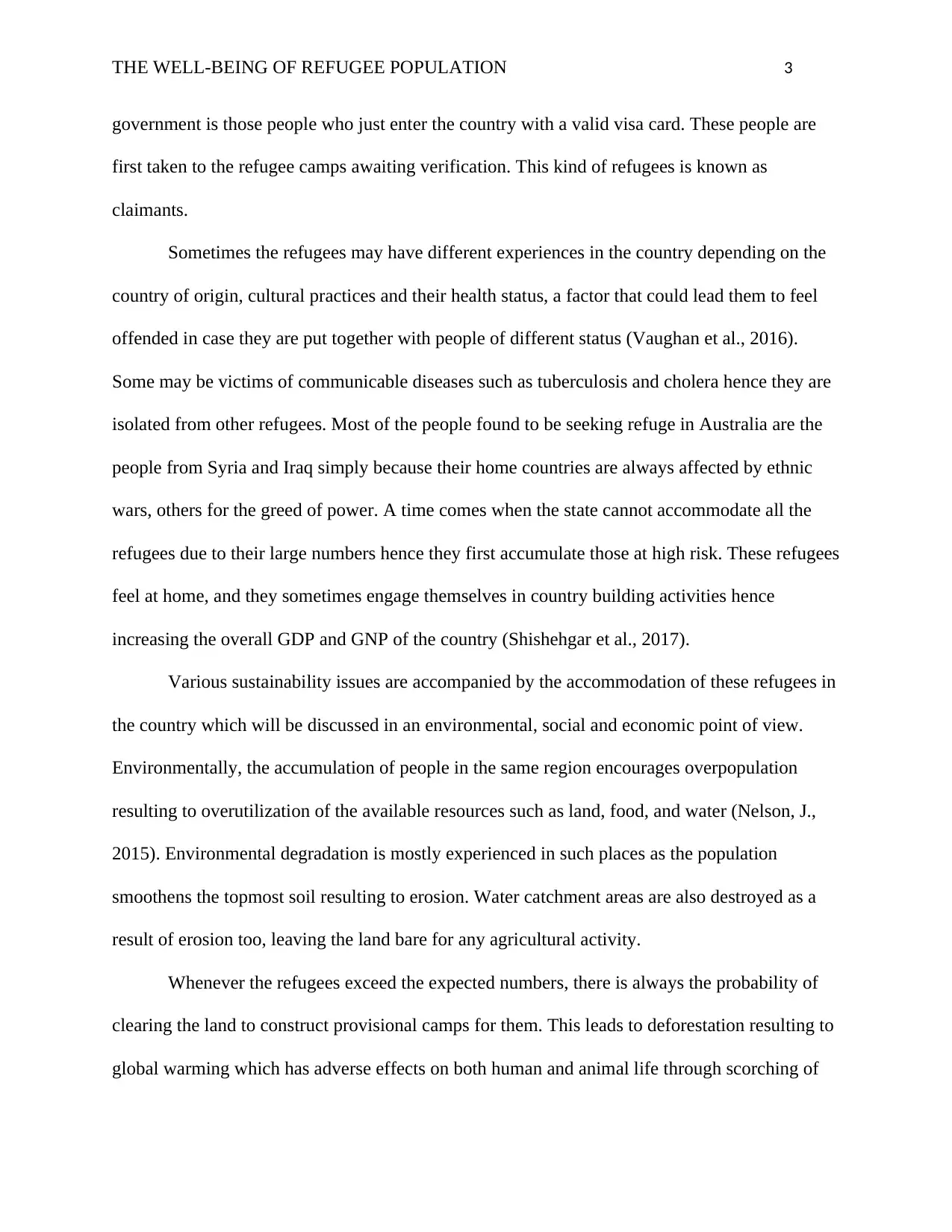
THE WELL-BEING OF REFUGEE POPULATION 3
government is those people who just enter the country with a valid visa card. These people are
first taken to the refugee camps awaiting verification. This kind of refugees is known as
claimants.
Sometimes the refugees may have different experiences in the country depending on the
country of origin, cultural practices and their health status, a factor that could lead them to feel
offended in case they are put together with people of different status (Vaughan et al., 2016).
Some may be victims of communicable diseases such as tuberculosis and cholera hence they are
isolated from other refugees. Most of the people found to be seeking refuge in Australia are the
people from Syria and Iraq simply because their home countries are always affected by ethnic
wars, others for the greed of power. A time comes when the state cannot accommodate all the
refugees due to their large numbers hence they first accumulate those at high risk. These refugees
feel at home, and they sometimes engage themselves in country building activities hence
increasing the overall GDP and GNP of the country (Shishehgar et al., 2017).
Various sustainability issues are accompanied by the accommodation of these refugees in
the country which will be discussed in an environmental, social and economic point of view.
Environmentally, the accumulation of people in the same region encourages overpopulation
resulting to overutilization of the available resources such as land, food, and water (Nelson, J.,
2015). Environmental degradation is mostly experienced in such places as the population
smoothens the topmost soil resulting to erosion. Water catchment areas are also destroyed as a
result of erosion too, leaving the land bare for any agricultural activity.
Whenever the refugees exceed the expected numbers, there is always the probability of
clearing the land to construct provisional camps for them. This leads to deforestation resulting to
global warming which has adverse effects on both human and animal life through scorching of
government is those people who just enter the country with a valid visa card. These people are
first taken to the refugee camps awaiting verification. This kind of refugees is known as
claimants.
Sometimes the refugees may have different experiences in the country depending on the
country of origin, cultural practices and their health status, a factor that could lead them to feel
offended in case they are put together with people of different status (Vaughan et al., 2016).
Some may be victims of communicable diseases such as tuberculosis and cholera hence they are
isolated from other refugees. Most of the people found to be seeking refuge in Australia are the
people from Syria and Iraq simply because their home countries are always affected by ethnic
wars, others for the greed of power. A time comes when the state cannot accommodate all the
refugees due to their large numbers hence they first accumulate those at high risk. These refugees
feel at home, and they sometimes engage themselves in country building activities hence
increasing the overall GDP and GNP of the country (Shishehgar et al., 2017).
Various sustainability issues are accompanied by the accommodation of these refugees in
the country which will be discussed in an environmental, social and economic point of view.
Environmentally, the accumulation of people in the same region encourages overpopulation
resulting to overutilization of the available resources such as land, food, and water (Nelson, J.,
2015). Environmental degradation is mostly experienced in such places as the population
smoothens the topmost soil resulting to erosion. Water catchment areas are also destroyed as a
result of erosion too, leaving the land bare for any agricultural activity.
Whenever the refugees exceed the expected numbers, there is always the probability of
clearing the land to construct provisional camps for them. This leads to deforestation resulting to
global warming which has adverse effects on both human and animal life through scorching of
⊘ This is a preview!⊘
Do you want full access?
Subscribe today to unlock all pages.

Trusted by 1+ million students worldwide
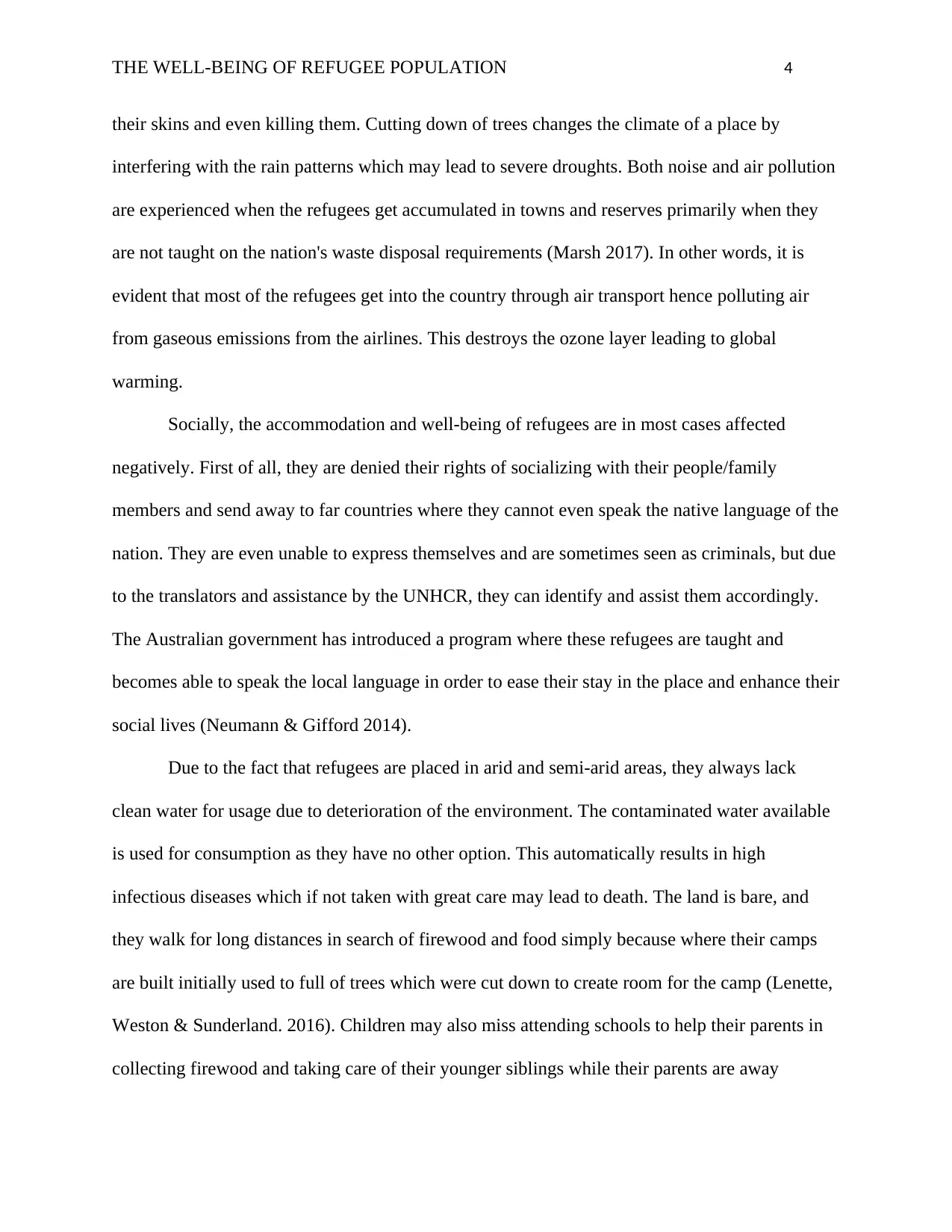
THE WELL-BEING OF REFUGEE POPULATION 4
their skins and even killing them. Cutting down of trees changes the climate of a place by
interfering with the rain patterns which may lead to severe droughts. Both noise and air pollution
are experienced when the refugees get accumulated in towns and reserves primarily when they
are not taught on the nation's waste disposal requirements (Marsh 2017). In other words, it is
evident that most of the refugees get into the country through air transport hence polluting air
from gaseous emissions from the airlines. This destroys the ozone layer leading to global
warming.
Socially, the accommodation and well-being of refugees are in most cases affected
negatively. First of all, they are denied their rights of socializing with their people/family
members and send away to far countries where they cannot even speak the native language of the
nation. They are even unable to express themselves and are sometimes seen as criminals, but due
to the translators and assistance by the UNHCR, they can identify and assist them accordingly.
The Australian government has introduced a program where these refugees are taught and
becomes able to speak the local language in order to ease their stay in the place and enhance their
social lives (Neumann & Gifford 2014).
Due to the fact that refugees are placed in arid and semi-arid areas, they always lack
clean water for usage due to deterioration of the environment. The contaminated water available
is used for consumption as they have no other option. This automatically results in high
infectious diseases which if not taken with great care may lead to death. The land is bare, and
they walk for long distances in search of firewood and food simply because where their camps
are built initially used to full of trees which were cut down to create room for the camp (Lenette,
Weston & Sunderland. 2016). Children may also miss attending schools to help their parents in
collecting firewood and taking care of their younger siblings while their parents are away
their skins and even killing them. Cutting down of trees changes the climate of a place by
interfering with the rain patterns which may lead to severe droughts. Both noise and air pollution
are experienced when the refugees get accumulated in towns and reserves primarily when they
are not taught on the nation's waste disposal requirements (Marsh 2017). In other words, it is
evident that most of the refugees get into the country through air transport hence polluting air
from gaseous emissions from the airlines. This destroys the ozone layer leading to global
warming.
Socially, the accommodation and well-being of refugees are in most cases affected
negatively. First of all, they are denied their rights of socializing with their people/family
members and send away to far countries where they cannot even speak the native language of the
nation. They are even unable to express themselves and are sometimes seen as criminals, but due
to the translators and assistance by the UNHCR, they can identify and assist them accordingly.
The Australian government has introduced a program where these refugees are taught and
becomes able to speak the local language in order to ease their stay in the place and enhance their
social lives (Neumann & Gifford 2014).
Due to the fact that refugees are placed in arid and semi-arid areas, they always lack
clean water for usage due to deterioration of the environment. The contaminated water available
is used for consumption as they have no other option. This automatically results in high
infectious diseases which if not taken with great care may lead to death. The land is bare, and
they walk for long distances in search of firewood and food simply because where their camps
are built initially used to full of trees which were cut down to create room for the camp (Lenette,
Weston & Sunderland. 2016). Children may also miss attending schools to help their parents in
collecting firewood and taking care of their younger siblings while their parents are away
Paraphrase This Document
Need a fresh take? Get an instant paraphrase of this document with our AI Paraphraser
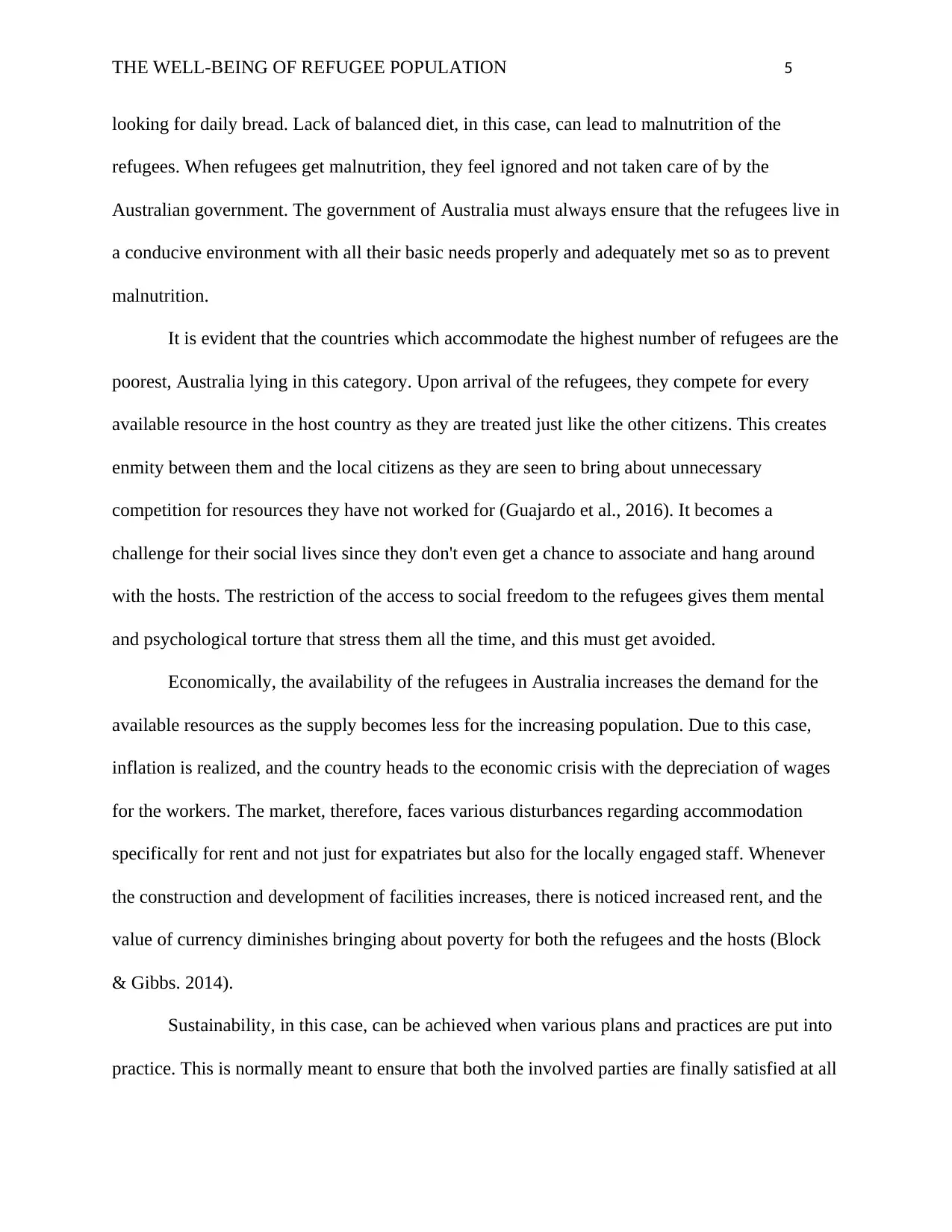
THE WELL-BEING OF REFUGEE POPULATION 5
looking for daily bread. Lack of balanced diet, in this case, can lead to malnutrition of the
refugees. When refugees get malnutrition, they feel ignored and not taken care of by the
Australian government. The government of Australia must always ensure that the refugees live in
a conducive environment with all their basic needs properly and adequately met so as to prevent
malnutrition.
It is evident that the countries which accommodate the highest number of refugees are the
poorest, Australia lying in this category. Upon arrival of the refugees, they compete for every
available resource in the host country as they are treated just like the other citizens. This creates
enmity between them and the local citizens as they are seen to bring about unnecessary
competition for resources they have not worked for (Guajardo et al., 2016). It becomes a
challenge for their social lives since they don't even get a chance to associate and hang around
with the hosts. The restriction of the access to social freedom to the refugees gives them mental
and psychological torture that stress them all the time, and this must get avoided.
Economically, the availability of the refugees in Australia increases the demand for the
available resources as the supply becomes less for the increasing population. Due to this case,
inflation is realized, and the country heads to the economic crisis with the depreciation of wages
for the workers. The market, therefore, faces various disturbances regarding accommodation
specifically for rent and not just for expatriates but also for the locally engaged staff. Whenever
the construction and development of facilities increases, there is noticed increased rent, and the
value of currency diminishes bringing about poverty for both the refugees and the hosts (Block
& Gibbs. 2014).
Sustainability, in this case, can be achieved when various plans and practices are put into
practice. This is normally meant to ensure that both the involved parties are finally satisfied at all
looking for daily bread. Lack of balanced diet, in this case, can lead to malnutrition of the
refugees. When refugees get malnutrition, they feel ignored and not taken care of by the
Australian government. The government of Australia must always ensure that the refugees live in
a conducive environment with all their basic needs properly and adequately met so as to prevent
malnutrition.
It is evident that the countries which accommodate the highest number of refugees are the
poorest, Australia lying in this category. Upon arrival of the refugees, they compete for every
available resource in the host country as they are treated just like the other citizens. This creates
enmity between them and the local citizens as they are seen to bring about unnecessary
competition for resources they have not worked for (Guajardo et al., 2016). It becomes a
challenge for their social lives since they don't even get a chance to associate and hang around
with the hosts. The restriction of the access to social freedom to the refugees gives them mental
and psychological torture that stress them all the time, and this must get avoided.
Economically, the availability of the refugees in Australia increases the demand for the
available resources as the supply becomes less for the increasing population. Due to this case,
inflation is realized, and the country heads to the economic crisis with the depreciation of wages
for the workers. The market, therefore, faces various disturbances regarding accommodation
specifically for rent and not just for expatriates but also for the locally engaged staff. Whenever
the construction and development of facilities increases, there is noticed increased rent, and the
value of currency diminishes bringing about poverty for both the refugees and the hosts (Block
& Gibbs. 2014).
Sustainability, in this case, can be achieved when various plans and practices are put into
practice. This is normally meant to ensure that both the involved parties are finally satisfied at all
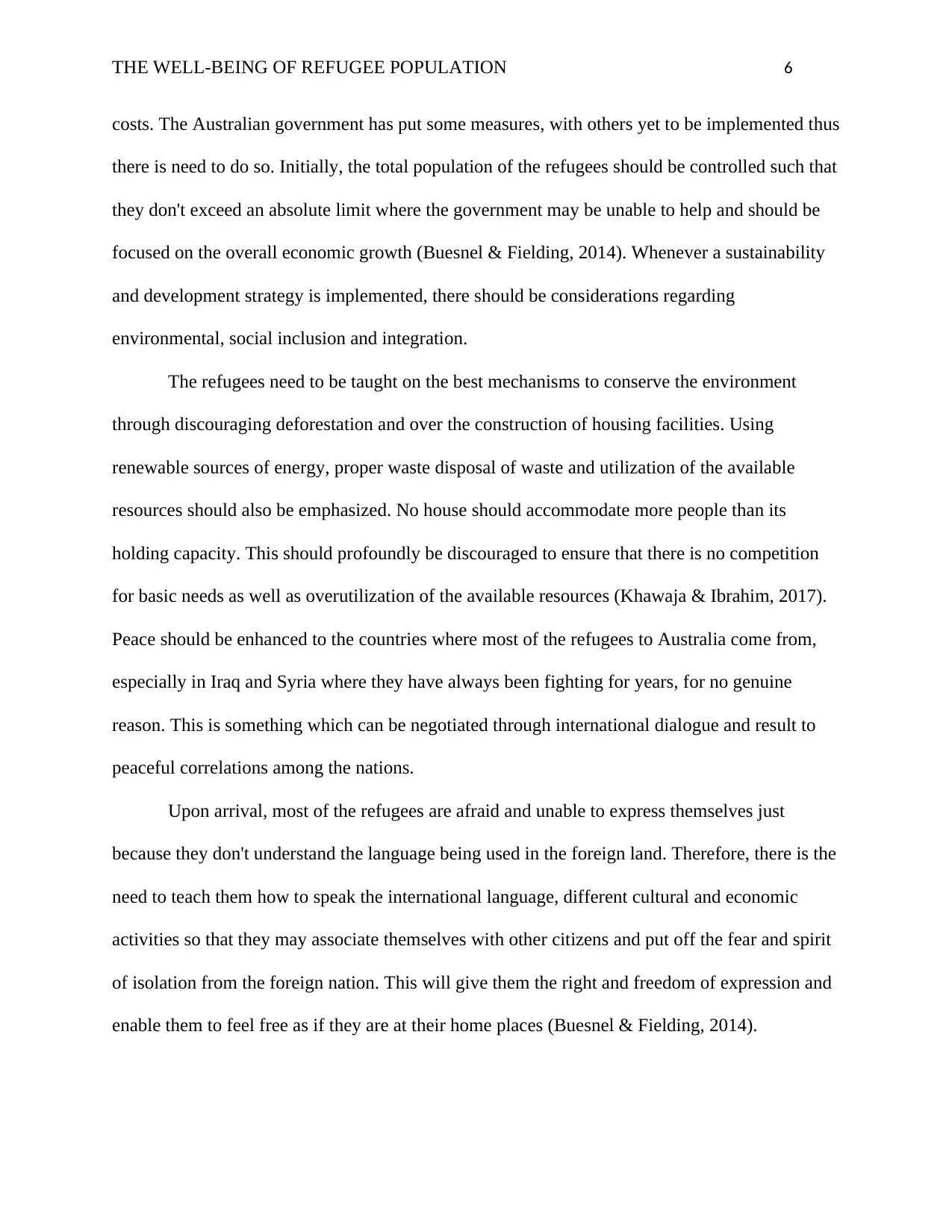
THE WELL-BEING OF REFUGEE POPULATION 6
costs. The Australian government has put some measures, with others yet to be implemented thus
there is need to do so. Initially, the total population of the refugees should be controlled such that
they don't exceed an absolute limit where the government may be unable to help and should be
focused on the overall economic growth (Buesnel & Fielding, 2014). Whenever a sustainability
and development strategy is implemented, there should be considerations regarding
environmental, social inclusion and integration.
The refugees need to be taught on the best mechanisms to conserve the environment
through discouraging deforestation and over the construction of housing facilities. Using
renewable sources of energy, proper waste disposal of waste and utilization of the available
resources should also be emphasized. No house should accommodate more people than its
holding capacity. This should profoundly be discouraged to ensure that there is no competition
for basic needs as well as overutilization of the available resources (Khawaja & Ibrahim, 2017).
Peace should be enhanced to the countries where most of the refugees to Australia come from,
especially in Iraq and Syria where they have always been fighting for years, for no genuine
reason. This is something which can be negotiated through international dialogue and result to
peaceful correlations among the nations.
Upon arrival, most of the refugees are afraid and unable to express themselves just
because they don't understand the language being used in the foreign land. Therefore, there is the
need to teach them how to speak the international language, different cultural and economic
activities so that they may associate themselves with other citizens and put off the fear and spirit
of isolation from the foreign nation. This will give them the right and freedom of expression and
enable them to feel free as if they are at their home places (Buesnel & Fielding, 2014).
costs. The Australian government has put some measures, with others yet to be implemented thus
there is need to do so. Initially, the total population of the refugees should be controlled such that
they don't exceed an absolute limit where the government may be unable to help and should be
focused on the overall economic growth (Buesnel & Fielding, 2014). Whenever a sustainability
and development strategy is implemented, there should be considerations regarding
environmental, social inclusion and integration.
The refugees need to be taught on the best mechanisms to conserve the environment
through discouraging deforestation and over the construction of housing facilities. Using
renewable sources of energy, proper waste disposal of waste and utilization of the available
resources should also be emphasized. No house should accommodate more people than its
holding capacity. This should profoundly be discouraged to ensure that there is no competition
for basic needs as well as overutilization of the available resources (Khawaja & Ibrahim, 2017).
Peace should be enhanced to the countries where most of the refugees to Australia come from,
especially in Iraq and Syria where they have always been fighting for years, for no genuine
reason. This is something which can be negotiated through international dialogue and result to
peaceful correlations among the nations.
Upon arrival, most of the refugees are afraid and unable to express themselves just
because they don't understand the language being used in the foreign land. Therefore, there is the
need to teach them how to speak the international language, different cultural and economic
activities so that they may associate themselves with other citizens and put off the fear and spirit
of isolation from the foreign nation. This will give them the right and freedom of expression and
enable them to feel free as if they are at their home places (Buesnel & Fielding, 2014).
⊘ This is a preview!⊘
Do you want full access?
Subscribe today to unlock all pages.

Trusted by 1+ million students worldwide
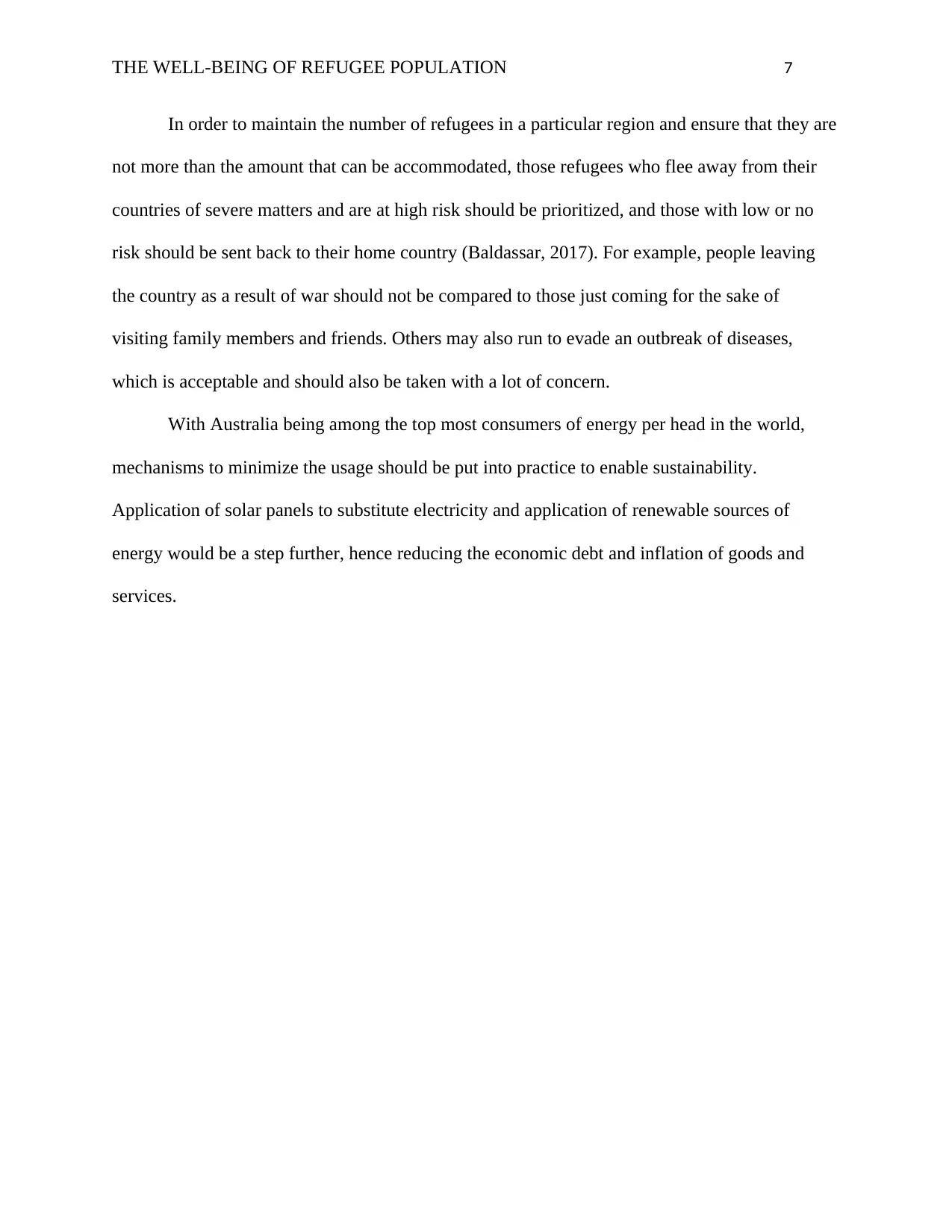
THE WELL-BEING OF REFUGEE POPULATION 7
In order to maintain the number of refugees in a particular region and ensure that they are
not more than the amount that can be accommodated, those refugees who flee away from their
countries of severe matters and are at high risk should be prioritized, and those with low or no
risk should be sent back to their home country (Baldassar, 2017). For example, people leaving
the country as a result of war should not be compared to those just coming for the sake of
visiting family members and friends. Others may also run to evade an outbreak of diseases,
which is acceptable and should also be taken with a lot of concern.
With Australia being among the top most consumers of energy per head in the world,
mechanisms to minimize the usage should be put into practice to enable sustainability.
Application of solar panels to substitute electricity and application of renewable sources of
energy would be a step further, hence reducing the economic debt and inflation of goods and
services.
In order to maintain the number of refugees in a particular region and ensure that they are
not more than the amount that can be accommodated, those refugees who flee away from their
countries of severe matters and are at high risk should be prioritized, and those with low or no
risk should be sent back to their home country (Baldassar, 2017). For example, people leaving
the country as a result of war should not be compared to those just coming for the sake of
visiting family members and friends. Others may also run to evade an outbreak of diseases,
which is acceptable and should also be taken with a lot of concern.
With Australia being among the top most consumers of energy per head in the world,
mechanisms to minimize the usage should be put into practice to enable sustainability.
Application of solar panels to substitute electricity and application of renewable sources of
energy would be a step further, hence reducing the economic debt and inflation of goods and
services.
Paraphrase This Document
Need a fresh take? Get an instant paraphrase of this document with our AI Paraphraser
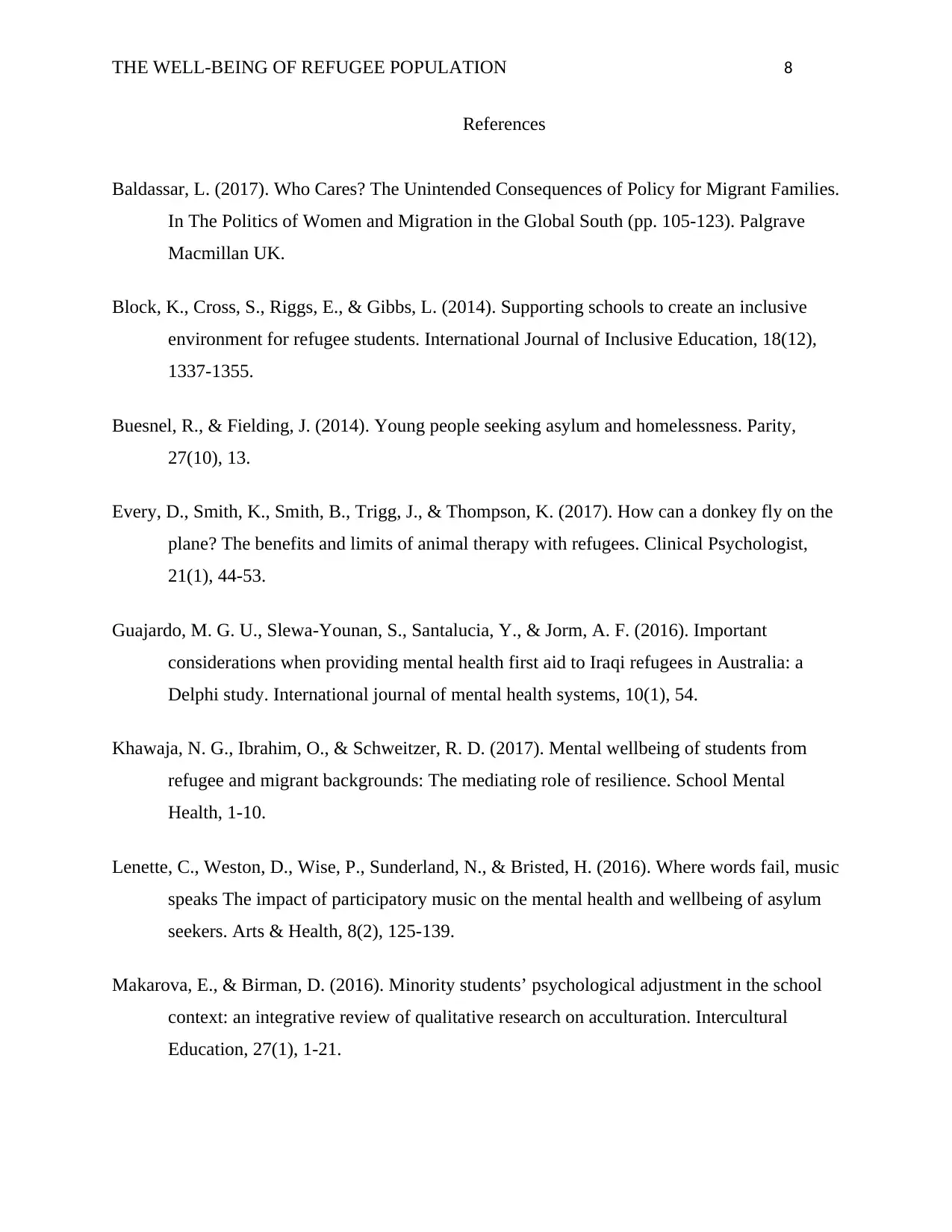
THE WELL-BEING OF REFUGEE POPULATION 8
References
Baldassar, L. (2017). Who Cares? The Unintended Consequences of Policy for Migrant Families.
In The Politics of Women and Migration in the Global South (pp. 105-123). Palgrave
Macmillan UK.
Block, K., Cross, S., Riggs, E., & Gibbs, L. (2014). Supporting schools to create an inclusive
environment for refugee students. International Journal of Inclusive Education, 18(12),
1337-1355.
Buesnel, R., & Fielding, J. (2014). Young people seeking asylum and homelessness. Parity,
27(10), 13.
Every, D., Smith, K., Smith, B., Trigg, J., & Thompson, K. (2017). How can a donkey fly on the
plane? The benefits and limits of animal therapy with refugees. Clinical Psychologist,
21(1), 44-53.
Guajardo, M. G. U., Slewa-Younan, S., Santalucia, Y., & Jorm, A. F. (2016). Important
considerations when providing mental health first aid to Iraqi refugees in Australia: a
Delphi study. International journal of mental health systems, 10(1), 54.
Khawaja, N. G., Ibrahim, O., & Schweitzer, R. D. (2017). Mental wellbeing of students from
refugee and migrant backgrounds: The mediating role of resilience. School Mental
Health, 1-10.
Lenette, C., Weston, D., Wise, P., Sunderland, N., & Bristed, H. (2016). Where words fail, music
speaks The impact of participatory music on the mental health and wellbeing of asylum
seekers. Arts & Health, 8(2), 125-139.
Makarova, E., & Birman, D. (2016). Minority students’ psychological adjustment in the school
context: an integrative review of qualitative research on acculturation. Intercultural
Education, 27(1), 1-21.
References
Baldassar, L. (2017). Who Cares? The Unintended Consequences of Policy for Migrant Families.
In The Politics of Women and Migration in the Global South (pp. 105-123). Palgrave
Macmillan UK.
Block, K., Cross, S., Riggs, E., & Gibbs, L. (2014). Supporting schools to create an inclusive
environment for refugee students. International Journal of Inclusive Education, 18(12),
1337-1355.
Buesnel, R., & Fielding, J. (2014). Young people seeking asylum and homelessness. Parity,
27(10), 13.
Every, D., Smith, K., Smith, B., Trigg, J., & Thompson, K. (2017). How can a donkey fly on the
plane? The benefits and limits of animal therapy with refugees. Clinical Psychologist,
21(1), 44-53.
Guajardo, M. G. U., Slewa-Younan, S., Santalucia, Y., & Jorm, A. F. (2016). Important
considerations when providing mental health first aid to Iraqi refugees in Australia: a
Delphi study. International journal of mental health systems, 10(1), 54.
Khawaja, N. G., Ibrahim, O., & Schweitzer, R. D. (2017). Mental wellbeing of students from
refugee and migrant backgrounds: The mediating role of resilience. School Mental
Health, 1-10.
Lenette, C., Weston, D., Wise, P., Sunderland, N., & Bristed, H. (2016). Where words fail, music
speaks The impact of participatory music on the mental health and wellbeing of asylum
seekers. Arts & Health, 8(2), 125-139.
Makarova, E., & Birman, D. (2016). Minority students’ psychological adjustment in the school
context: an integrative review of qualitative research on acculturation. Intercultural
Education, 27(1), 1-21.
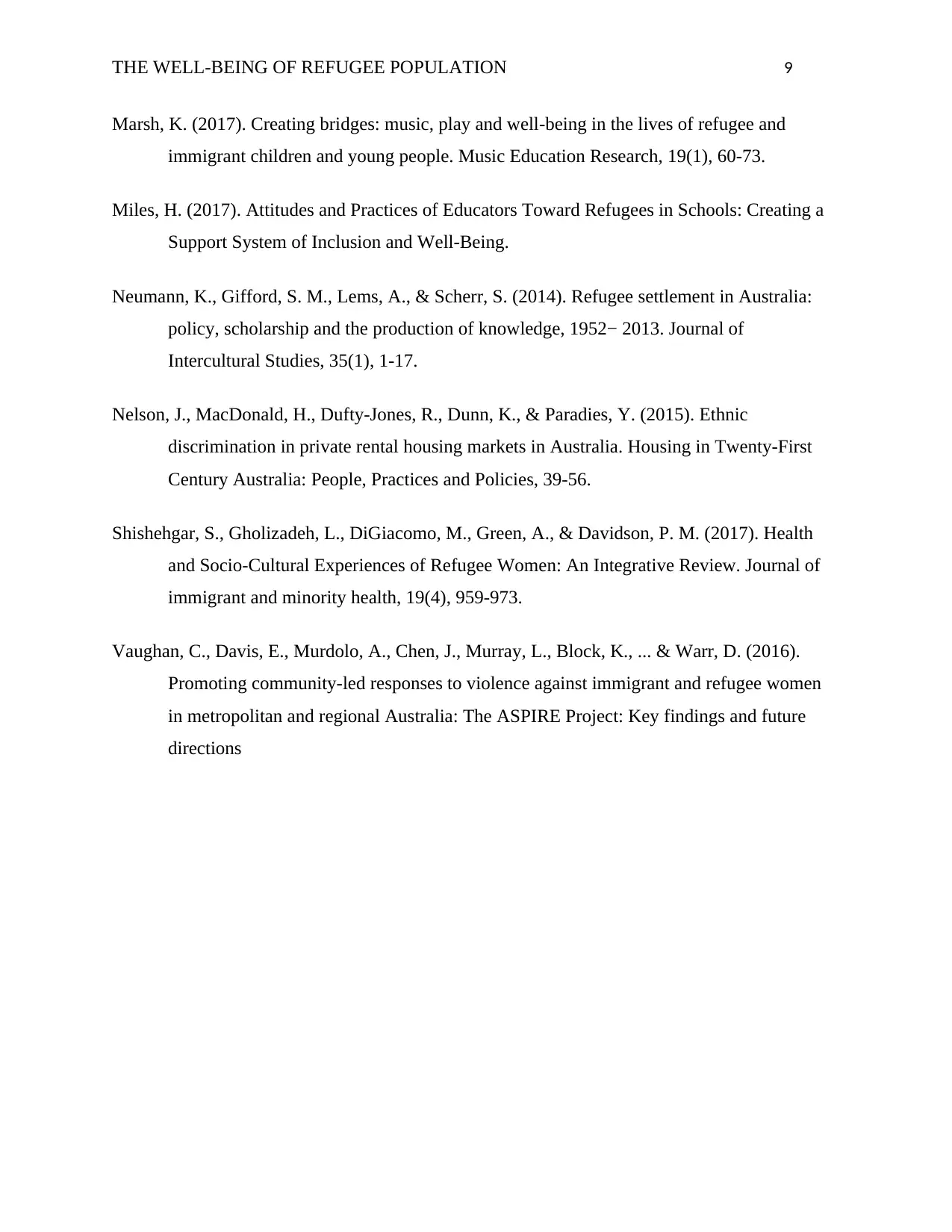
THE WELL-BEING OF REFUGEE POPULATION 9
Marsh, K. (2017). Creating bridges: music, play and well-being in the lives of refugee and
immigrant children and young people. Music Education Research, 19(1), 60-73.
Miles, H. (2017). Attitudes and Practices of Educators Toward Refugees in Schools: Creating a
Support System of Inclusion and Well-Being.
Neumann, K., Gifford, S. M., Lems, A., & Scherr, S. (2014). Refugee settlement in Australia:
policy, scholarship and the production of knowledge, 1952− 2013. Journal of
Intercultural Studies, 35(1), 1-17.
Nelson, J., MacDonald, H., Dufty-Jones, R., Dunn, K., & Paradies, Y. (2015). Ethnic
discrimination in private rental housing markets in Australia. Housing in Twenty-First
Century Australia: People, Practices and Policies, 39-56.
Shishehgar, S., Gholizadeh, L., DiGiacomo, M., Green, A., & Davidson, P. M. (2017). Health
and Socio-Cultural Experiences of Refugee Women: An Integrative Review. Journal of
immigrant and minority health, 19(4), 959-973.
Vaughan, C., Davis, E., Murdolo, A., Chen, J., Murray, L., Block, K., ... & Warr, D. (2016).
Promoting community-led responses to violence against immigrant and refugee women
in metropolitan and regional Australia: The ASPIRE Project: Key findings and future
directions
Marsh, K. (2017). Creating bridges: music, play and well-being in the lives of refugee and
immigrant children and young people. Music Education Research, 19(1), 60-73.
Miles, H. (2017). Attitudes and Practices of Educators Toward Refugees in Schools: Creating a
Support System of Inclusion and Well-Being.
Neumann, K., Gifford, S. M., Lems, A., & Scherr, S. (2014). Refugee settlement in Australia:
policy, scholarship and the production of knowledge, 1952− 2013. Journal of
Intercultural Studies, 35(1), 1-17.
Nelson, J., MacDonald, H., Dufty-Jones, R., Dunn, K., & Paradies, Y. (2015). Ethnic
discrimination in private rental housing markets in Australia. Housing in Twenty-First
Century Australia: People, Practices and Policies, 39-56.
Shishehgar, S., Gholizadeh, L., DiGiacomo, M., Green, A., & Davidson, P. M. (2017). Health
and Socio-Cultural Experiences of Refugee Women: An Integrative Review. Journal of
immigrant and minority health, 19(4), 959-973.
Vaughan, C., Davis, E., Murdolo, A., Chen, J., Murray, L., Block, K., ... & Warr, D. (2016).
Promoting community-led responses to violence against immigrant and refugee women
in metropolitan and regional Australia: The ASPIRE Project: Key findings and future
directions
⊘ This is a preview!⊘
Do you want full access?
Subscribe today to unlock all pages.

Trusted by 1+ million students worldwide
1 out of 9
Related Documents
Your All-in-One AI-Powered Toolkit for Academic Success.
+13062052269
info@desklib.com
Available 24*7 on WhatsApp / Email
![[object Object]](/_next/static/media/star-bottom.7253800d.svg)
Unlock your academic potential
Copyright © 2020–2025 A2Z Services. All Rights Reserved. Developed and managed by ZUCOL.





